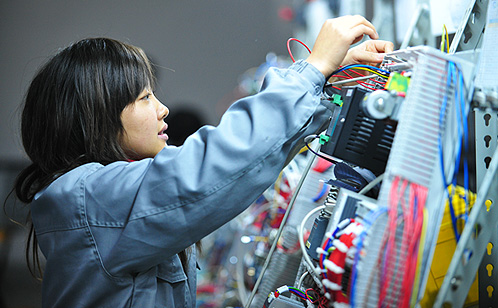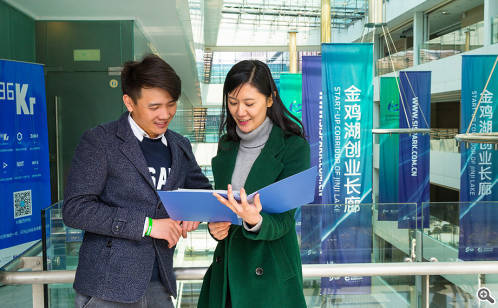New Interpretation of SIP Development by Innovation
Suzhou Industrial Park persists in development by way of high-tech and innovation, implements the innovation-driven strategy, and clusters all innovative elements in recent years. It optimizes and improves the high-tech service system, which boosts the vigor of innovation and uplifts the quality and effectiveness of development, highlighting the innovation of SIP's development.
Ongoing construction of innovation system
With a myriad of honorable titles, such as National Science-Finance Integration Demonstration Zone, National Technological Service Demonstration Zone, and one of the first Patent-Guided Emerging Industry Experimental Zones of China, SIP has become the "innovation example" for those in Jiangsu and even across the country. Speaking of various indicators, such as ranking of innovation capacity in national development zones and high-tech zones, output value and proportion of high-tech industries, the number of national high-tech enterprises, the number of talents recognized in the Recruitment Program of Global Experts and others, it tops all other places in Jiangsu and is in the lead across the country.
In order to build a sustainable innovation system, SIP increases investment in innovation and R&D, with 3.35% R&D input out of GDP, and the number of valid patent ownership per 10,000 people exceeds 60 pieces. Up to now, 51 national R&D agencies cluster in SIP, led by Suzhou Institute of Nano-Tech and Nano-Bionics (SINANO), Chinese Academy of Sciences, which also include national enterprise technology center and national engineering research center. The Vacuum Interconnected Nanotech Workstation (Nano-X) has been launched. 224 R&D institutions are built by foreign-invested enterprises, 253 R&D institutions built by large and medium-sized industrial enterprises, and 6 national and provincial & municipal technology transfer institutes are also built, forming a complete innovation and R&D system including sci-tech institutes, technology transfer institutes and enterprise R&D setups.
Optimized structure of innovative industries
SIP has developed and implemented the "2+3" industrial development plan, which focuses on two leading industries (electronic information and machinery equipment) and three strategic new-emerging industries (biomedicine, nanotech application, and cloud computation). It emphasizes on the highlights and directions of transformation and upgrading, and publishes after intense research the development plan and support policies such as promoting the strategic new-emerging industries and fostering enterprises of independent brands. The output value of the three new-emerging industries including the nanotech application enjoys an annual growth of around 30%.
The industrial output value of high-tech industry realized in 2014 amounted to 273.3 billion yuan, accounting for 68.4% of that achieved by enterprises above a designated scale; the added value of service industry out of GDP increased about 2 percentage points every year, which achieved 41.3% last year. It is not difficult to tell that from the dominance of manufacturing industry to the switch to new-emerging industries, the industrial structure in SIP has undergone a dramatic reform. By now, SIP has accumulatively 630 national-level high-tech enterprises, 97 technologically advanced service enterprises, 14 listed companies, and 22 companies listed on the "New Three Board". The sales volume of 50 enterprises with independent brands has exceeded 100 million yuan each.
Promoting brands by innovative services
As the first batch of Pilot Units in Building National Torch Technological Service System, SIP so far has built over 3,600,000 square meters of high-tech carriers. With 12 provincial-level and higher-level scientific incubators, it has built 30 public platforms and more than 10 cooperation and exchange platforms for international science and technology based on the needs of industrial technology.
In addition, SIP also gathers more than 660 financial institutions, and Sandlake VC/PE Community has clustered over 100 equity investment institutions, with a fund size of 53 billion yuan. It embraces a batch of high-tech branches, high-tech insurance agencies, small loan companies, science-finance supermarkets and financing lease companies, and provided financial support of more than 3 billion yuan to over 600 SMEs last year.
As a SME service center offering "baby-sitting" services to innovative technological enterprises, it covers 15 areas such as intellectual property rights, human resources, science-finance, finance-tax service and legal consultancy. 19 cloud innovative incubators are at service for popular entrepreneurship and innovation, among which 8 have been included by the Ministry of Science and Technology into the national-level science enterprise incubator management system, forming a "Jinji Lake startup corridor".
Innovative talents clusters
26 institutions of higher learning and vocational colleges are located in Suzhou Dushu Lake Science and Education Innovation District with 77,000 students, among whom there are nearly 20,000 postgraduates or above, thus making the district the first national demonstration zone on internationalized higher education. In respect to the attraction of high-end talents, SIP has accumulatively introduced 730 sci-tech leading talents, with 114 talents in the National Recruitment Program of Global Experts, 119 selected as the Jiangsu "Innovation and Business Talents", and 180 selected as Gusu Leading Talents; it has by now attracted more than 1,000 foreign experts, and 5,000 talents returning from overseas have started up more than 500 enterprises, which together makes SIP ranking top among national development zones in terms of the total number of talents.
Relying on the resource advantages of Chinese and foreign colleges and universities, sci-tech research institutes and other carriers, SIP also realize the favorable interaction of "government, industry, education, research, capital, and agent", forming the multi-lateral cooperation mechanism. Collaborative Innovation Center of Suzhou Nano Science and Technology is elected into the national "2011 Program", and becomes the innovation base for Suzhou nano-tech industry which combines the science and education. An array of technical alliances or industrial alliances are organized such as for nano-tech application, cloud computing, nucleic acid medicine and integrated communication, and branded activities such as Lakeside Forum and College Forum have scored great achievements, thus creating a lively atmosphere for innovation and startup.
May 19, 2015


